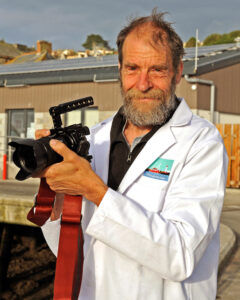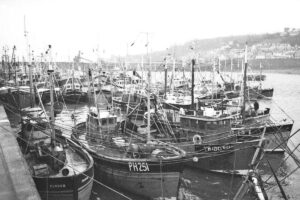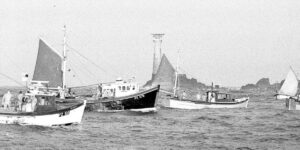Through the Gaps!
If you want to keep up with the daily happenings at Newlyn, with pictures and gossip from the port’s fishing industry, then the informative ‘Through the Gaps’ is the place to go: blog.through-the-gaps.co.uk
Run by ex-skipper Larry Hartwell, there isn’t much about Newlyn’s daily goings-on that you won’t find on Through the Gaps.
Larry and I first met in 1983 at a commercial fishing show held at Pendennis, Falmouth – an event staged by Fishing News.

Larry Hartwell at Newlyn, capturing events – he has his own small workspace in a fisherman’s storage unit, a kettle, and his uniform for the market.
Larry worked on bigger boats, mainly from Newlyn, and I was fishing inshore from Flushing (Falmouth). Larry and I have plenty in common: both born and raised in land-locked cities, both moving to Cornwall as teachers, both with a love for the fishing industry, and both with a love of eating fish.
Larry was (and remains) a brilliant fish cook, I was an avid learner, and together with our families, we tried all sorts of fish dishes.
Although I’ve eaten fish all my life, everything had to be cooked as quickly as possible – grilled or ‘battered plus chips’, and perhaps the occasional fish pie. As a kid, I had holidays in Portland, and had seen the potters at work, and line fishing for bass, too. Mum was a chef, and fish was cheap food.
On brief escapes from London, Larry also had a taste of true fishing, and saw how the ‘fish’ in ‘fish and chips’ was caught. He had no idea that he would one day catch it himself!
Although we both escaped to Cornwall as teachers – and were teachers at heart – we saw the duties of teachers change in the early 1980s, when teachers became form-fillers and social workers. I wanted to fish, and so did Larry. In fact, by 1983 we were both earning a living from the sea.
Larry was at Newlyn, where a stream of Breton boats often berthed; he can speak broken French, so there was a degree of communication there. Even better, the French language used aboard the Breton boats was also ‘broken’, because Bretons are not French. Even today, many Breton fishermen speak Breton as a first language.
True Bretons have as little to do with the French as possible – a bit like the early Cornish, where the Cornish language was the mother tongue. Even today, memories of so many atrocities brought upon the Cornish by the English remain raw.
Larry spent time aboard the Breton boats, and he saw fishermen take time preparing, cooking and eating fish. As a result, Larry discovered that style of cooking long before Rick Stein promoted fish on television.
Geologically, Newlyn ‘fits’ better in Brittany than it does in England. Compare St Michael’s Mount – a stone’s throw from the Gaps – and its replica Mont Saint-Michel. Even though Mont Saint-Michel is in Normandy, it is a mirror image of St Michael’s Mount.
There are still Cornish fishermen who deem Breton fishermen ‘brothers’, and when fishing in distant waters or working inside the 200-mile French limits, quite a few Newlyn boats land fish in ports like Guilvinec or Douarnenez.

Larry’s shot of the WS&S sidewinders many years ago. With a wry smile, Larry said: “Sidewinding – that’s real trawling!”
Larry and his wife Leah lived in a wee cottage overlooking Newlyn harbour, and my lassie and I lived close to the quay in Flushing. Fishing was important to all four of us; it brought an income. However, after continually losing netting gear to scallopers, I sold my 25ft boat and bought a GM19, Charlotte Louise, for part-time work, and bought a new, dark blue Metro van (driven by a 999cc engine!) which became my cheap camper van. I travelled far and wide, hunting for news.
At the same time, still fishing, Larry used his photographic skills to literally ‘capture’ fishing at Newlyn, and as a dab hand at sketching and watercolours, his work at sea was often transcribed through a pencil, charcoal or paintbrushes. His little-known work is truly superb. Larry found Fishing News as a way to share his photos. He still submits pictures to Fishing News. You can tell Larry’s pictures from mine: Larry’s shots have artistic composition, mine are clinical!
By the early 1980s, Larry was working on an ex-French stern trawler, the Keriolet (skipper/owner Traz Treloar), often fishing the prawn grounds in the Celtic Sea. Larry tells of codend breaks because there was too much to lift. Money being made by Newlyn men was significant. In the 1980s, the port was expanding fast. Old sidewinders became beamers, like Marie Claire, Elizabeth Caroline and Elizabeth Ann Webster, and although second-hand Dutch beamers were like gold dust, Newlyn vessel owner W Stevenson & Sons (WS&S) invested heavily to develop a considerable fleet of such vessels.
Brixham was in competition to buy an even bigger fleet of Dutch boats – ironic, really, because beam trawling was invented in Brixham in the 1600s, but the Dutch grabbed the idea, and by the 1700s, did equally well beam trawling with sail power. Even more ironic is the fact that for the past 40 years, the Dutch have sold their beamers back to us, or built new ones for us!

A shot from the early 1980s, at least three years before Phil Lockley began taking photos of the Cornish fishing industry.
Everything in the Cornish fishing industry of the mid to late 1980s was expanding. Grants underpinned new-builds, those who invested in smaller boats soon moved to bigger boats, and a monofilament gill-net fleet grew at a frightening pace.
And whichever way that the prime fish off Newlyn was being caught, the surnames of those who caught it became legendary – Stevens (St Ives), Pascoe, Turtle, George, Hooper, Senior, Hicks, Mitchell, Hosking, Hill, Neal, Tonkin, Corin, Thomas, Jenkins, Harvey, Downing and many others.
Let’s jump ahead 36 years. I’m typing this Inshore Corner on the latest model of iMac computer, an instrument with hundreds of thousands of times the power used for the moon landing.
In all likelihood, Larry is sitting with a mug of tea, tapping away on his iMac, entering the latest daily entries of news, gossip and pictures in Through the Gaps.
‘Through the Gaps’ means entering or leaving Newlyn harbour. Spend some time on Larry’s website and you will want to see the Gaps, and see more of Newlyn. It is a remarkable place, now undergoing major changes – but since its inception in the 17th century, ‘Newlyn was fishing’ and ‘fishing was Newlyn’.
For the historians among us, Street An Nowan was a new town that grew up in the 17th century in a triangle of land between Newlyn Town, Paul Hill and the beach. As the settlement grew, it linked Newlyn Town with the previously separate coastal settlement of Tolcarne. There remains heated banter between Newlyn folk who live east of the stream, and those who live west of the stream! Never the twain shall meet!

Larry’s shot of hand-line boats, midway through the mackerel boom, when he was aboard the Kim-Bill. Boy Anthony PZ 518 is far left, and the black boat is Boy Gary PZ 576. Larry took this picture at first light, by pushing the speed of the black and white film and spending hours in his darkroom to get the best from a near-impossible task.
Newlyn is intrinsically Cornish, and is different to other British ports. Its artistic history is legendary, with people like Stanhope Forbes capturing the Newlyn fishing industry on canvas. For hundreds of years, possibly longer, Newlyn has nurtured craftsmen, boatbuilders, engineers, fish merchants and fishermen – and its fleet now delivers some of the finest fish in Europe.
Here’s what Larry says on his Through the Gaps website: “Welcome to Through the Gaps, the UK’s most comprehensive information, and images of Cornwall’s finest fishing resource. Newlyn fishmarket handles the finest hand-line, trawl, net and pot-caught fish and shellfish. Newlyn prides itself on products such as MSC-certified hake, MSC-certified Cornish sardines, and, of equal rating, promotes its line-caught bass, pollack and mackerel.”
Take a trip through the past three and a half decades with Larry Hartwell.
He said, “I came to Newlyn, fell in love with the place, packed my bags in London, and searched for a teaching job near Newlyn. But in those days, getting a teaching post in Cornwall meant waiting for a teacher to die!
“So I started as a deckie on the Girl Freda – an ex-Scottish 55-footer – with skipper Bobbie Cairns from Milford – a very successful boat, and a successful skipper. I then worked on the Kim-Bill with skipper Bill Tonkin. Previously, the boat was named Bonny Mary, but after purchase, Bill Tonkin changed the name to reflect his daughter, Kim, and his son, Bill.
“I then went long-lining for skate, then trawling on the Fern with skipper Alan Goddard, then trawling on the ex-French 60-footer Keriolet, where I got my second hand ticket – after which, in about 1988, I skippered the 80ft trawler Dumnonia. In fact, I skippered the Dumnonia three times, because each time it went to Rockall, my second hand ticket was insufficient. Over my time in fishing, I either worked aboard or skippered quite a few boats.
“By about 1994, I had skippered the WS&S sidewinder Jaqueline, and also skippered its netter Trewarveneth – but I decided to pop back into teaching, and eventually became a lecturer at Penwith College.
“That’s when my idea of getting to know more about the web began. The web was only three years old. I started writing websites like Newlyn harbour, and then yours, Mr Lockley!” (Yes, he did – it was called By-Water Productions. It was a great website and brought me a lot of video work.)

The sidewinder Jacqueline at work. Larry took this picture not long before he became skipper of the vessel.
“Together with Bill Tonkin aboard the Silver Harvester, I helped organise trials of Inmarsat C communications during the ‘tuna wars’ – a period of several weeks where a conflict between Spanish pole fishermen and Cornish drift-netters heightened.
“I carried out similar work aboard the netter Sowenna, helping to secure long-distance communications.
“I also tried to get Newlyn to be the first remote electronic computer fish auction in the UK. My work to promote the idea was with Schelfout (now Aucxis), Europe’s biggest internet auction company. That was in 1994, before the web as we know it today!
“Building a website in those days, when the issue was having enough computer memory to ‘work the web’, was difficult. Nowadays, you can buy a 2TB (terabyte) hard drive for £50; in those days, 500MB (a fraction of 2TB) would cost well over £500.
“As more software for building websites became available, I began to build more websites, often using my pictures; and later, I wrote websites for inshore fishermen who wanted to sell fish and/or shellfish direct to the customer. Other websites were to promote species like hake, when its export market to Spain collapsed (2012).
“That website was in action just before the fishery achieved its MSC accreditation. Quite soon, there became a fast-growing demand for hake in the UK. I believe that 80% of the hake landed to Newlyn is now consumed in the UK. That website is based on the netter Ajax.
“In May 2006, I started the blog Through the Gaps.

Larry’s watercolour of what it was like working on the Keriolet – ‘one of the finest boats ever’, he said.
“The idea was to use the blog as a promotion for the Newlyn fishing industry, and on the test run, it showed pictures of the harbour development of that time – the pontoons were being installed. But the weather was poor, and my first entry, on Saturday, 20 May, 2006, said, ‘Northerly gale and no fish!’
“In no time, there was quite a good take-up of people clicking on to Through the Gaps, and nowadays, we average over 30,000 hits a month – that’s about 2.5 million since the blog started.”
Larry holds a position on the harbour advisory board, and he spends many mornings each month on the fishmarket capturing what’s been caught. Basically, if there’s anything that’s interesting at Newlyn, Larry will break from his ‘sort-of’ retirement to capture that event – even film it – and then post it on Through the Gaps.
Larry has seen many years pass by at Newlyn, seeing the fleet go through its highs and lows. He describes today’s Newlyn fishing industry as ‘dynamic’, and predicts that the Cornish port will develop ‘much further’. He is in no doubt that Cornish fish from Newlyn fishmarket will develop an even greater following.
I had better finish this off, because it’s now time to take from my oven a steak of MSC-accredited hake, bought from the WS&S fish retailer a few yards from the market. Piled with onions, a bit of butter and a slice of lemon, it was all sealed in foil, then braised at a low oven temperature for over an hour – a Cornish recipe. Try it – it’s fantastic.








